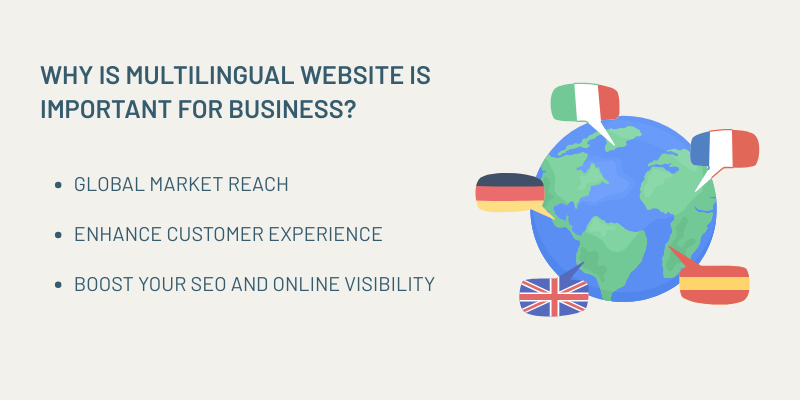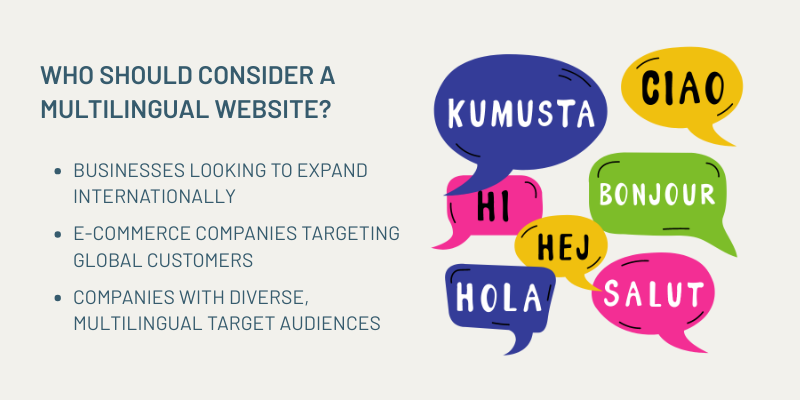In today’s digital world, businesses are no longer restricted to local markets, creating opportunities to reach customers worldwide.
This is where having a multilingual website becomes essential. It allows companies to connect with global audiences, overcome language barriers, and deliver meaningful customer experiences.
When people can browse and shop in their native language, they feel more comfortable and are more likely to trust your brand.
This is crucial for businesses that are actively focusing on SEO ranking report software to measure their online presence and improve their digital marketing effectiveness.
Thus, by offering content in multiple languages, businesses can build trust, improve customer satisfaction, and increase their chances of success in international markets.
In this article, we’ll explore why is a multilingual website important for businesses and how it can help drive growth on a global scale.
What is a Multilingual Website?
A multilingual website is a site that provides content in multiple languages, allowing users to choose the language they are most comfortable with.

For businesses looking to reach international audiences and grow in global markets, multilingual website development is essential.
Without it, you risk missing out on valuable opportunities to connect with potential customers worldwide, especially in regions where search engines like DuckDuckGo vs Google have different user preferences and behaviors.
Why is a Multilingual Website Important for Businesses?
In an increasingly interconnected world, having a multilingual website is no longer optional for businesses aiming to expand their reach and enhance customer engagement. By leveraging multilingual web development, businesses can break down language barriers and cater to global markets more effectively.

Here are several compelling reasons why a multilingual website is important:
1. Global Market Reach
Expanding into new markets, increasing brand visibility across different regions and languages, and tapping into non-English speaking audiences are crucial strategies for businesses aiming to grow in today's interconnected world.
A multilingual website plays a pivotal role in achieving these objectives.
-
Expanding into New Markets
A multilingual website enables businesses to enter and establish a presence in international markets, offering products or services to a broader audience.
By providing content in multiple languages, companies can cater to the preferences of diverse customer bases, facilitating smoother market entry and acceptance.
A multilingual website plays a pivotal role in achieving these objectives. For example, companies with multilingual sites can better engage potential customers who are searching using Google keyword ranking metrics.
-
Increasing Brand Visibility Across Different Regions and Languages
Offering content in various languages enhances a brand's visibility and recognition in different regions.
It allows businesses to connect with local audiences more effectively, demonstrating cultural sensitivity and commitment to serving their needs, which can lead to increased brand loyalty and customer trust.
-
Tapping into Non-English Speaking Audiences
Engaging non-English speaking audiences is essential for global growth.
A multilingual website ensures that language barriers do not hinder potential customers from accessing information, making purchases, or engaging with the brand.
This inclusivity can significantly expand a company's reach and customer base.
Explore Our Web Design & Development Services!
2. Enhanced Customer Experience
One of the main reason that why is multilingual website important for business is to enhance customer experience by providing content in a customer's native language significantly improves their experience, leading to higher engagement and satisfaction.
Here's how:
- Native Language Content: Offering content in the customer's preferred language ensures clarity and comfort, reducing misunderstandings and enhancing the overall user experience.
- Cultural Relevance: Tailoring content to reflect local customs and preferences fosters a deeper connection with users, making them feel valued and understood.
Thus, communicating in the user's native language demonstrates commitment to their needs, building trust and credibility for your brand.
3. Boost Your SEO and Online Visibility
Implementing a multilingual website significantly enhances your site's search engine optimization (SEO) and online visibility, enabling you to reach a broader, more diverse audience. Offering multilingual content can lead to better engagement across various regions, as users are more likely to interact with content in their native language.
Here's how
-
Improved Search Engine Rankings in Different Languages
Search engines like Google prioritize content that matches the user's language preferences, improving your site's ranking in international search results.
This can boost your visibility significantly, especially when paired with SEO services designed to cater to multilingual content.
-
Increased Organic Traffic from Global Search Engines
A multilingual website attracts organic traffic from global search engines, as users are more likely to find and engage with content in their native language.
By offering content in multiple languages, businesses can reach audiences that use different top search engines across various regions.
-
Reaching Customers Who Search in Their Native Language
Many users prefer to search for information in their native language. By providing content in multiple languages, you cater to these preferences, enhancing user experience and engagement.
This approach not only broadens your audience base but also builds trust and credibility with international customers.
Explore Our Digital Marketing Services!
Legal and Cultural Sensitivity in Multilingual Websites
When considering the value of a multilingual website for business success, that why is multilingual website important for business than it is equally essential to address legal and cultural sensitivity.
Ensuring compliance with regional laws and respecting cultural nuances not only prevents legal issues but also fosters trust and engagement among diverse audiences.
Partnering with a digital transformation agency like Centric can help businesses navigate these complexities while ensuring their multilingual websites are optimized for global engagement.
By integrating these considerations, businesses can create inclusive and legally sound digital experiences that resonate with global users.
Here's how businesses can ensure compliance and respect diverse audiences:
1. Legal Compliance Across Regions
Ensuring multilingual websites adhere to regional laws is crucial; for instance, the European Accessibility Act mandates accessibility standards across EU member states, while the Americans with Disabilities Act (ADA) requires compliance in the U.S.
- Adhering to Regional Laws: Different countries have specific regulations governing online content. For instance, the European Union's Web Accessibility Directive mandates that public sector websites meet accessibility standards, while Canada's Bill 96 requires businesses to provide services in both English and French.
- Multilingual Privacy Policies: Regulations like the GDPR and CCPA necessitate clear and accessible privacy policies in the user's language. Inadequate translations can lead to legal challenges and loss of user trust.
- Accessibility Standards: Compliance with Web Content Accessibility Guidelines (WCAG) 2.1 ensures that websites are usable by people with disabilities. This includes providing content in multiple languages and formats.
2. Cultural Sensitivity in Localization
Cultural sensitivity in localization involves adapting content to align with the cultural norms, values, and preferences of a target audience, ensuring that messaging resonates appropriately and avoids misunderstandings.
Companies in industries such as oil and gas marketing agency may find these nuances especially important when catering to diverse global markets.
- Understanding Cultural Context: Literal translations can lead to misunderstandings. For example, idiomatic expressions like "break a leg" may be confusing or offensive in other cultures
- Adapting Visual Elements: Design elements such as colors, symbols, and imagery should be culturally appropriate. What is considered positive in one culture may have negative connotations in another.
- Tailoring Content to Local Preferences: Adjusting content to align with local customs, values, and expectations enhances user engagement and demonstrates respect for the audience's culture.
Real-Life Examples of Multilingual Websites
Here are some notable real-life example of companies that have effectively utilized multilingual websites:
1. Gymshark: Fitness Apparel Brand
Gymshark, a UK-based fitness apparel brand, has expanded its reach by offering its website in 18 languages.
The company tailors product lines to specific regions, partners with local influencers, and implements marketing campaigns that align with the preferences of each target audience.
This personalized approach has helped Gymshark achieve global brand recognition. And this shows how web design and development tailored to different languages can increase a brand’s success.
2. Netflix: Streaming Service
Netflix provides its website in multiple languages, offering localized interfaces and subtitles. This multilingual approach has allowed Netflix to cater to a global audience, enhancing user experience and satisfaction.
This is how digital transformation can help expand a brand's reach.
Who Should Consider a Multilingual Website?
In an increasingly interconnected world, businesses aiming to expand their reach and enhance customer engagement should consider implementing a multilingual website.

1. Businesses Looking to Expand Internationally
Expanding into new markets requires effective communication with diverse audiences. A multilingual website enables businesses to bridge language barriers, making their products or services accessible to a broader customer base.
This approach not only facilitates market entry but also fosters trust and credibility among international customers.
2. E-commerce Companies Targeting Global Customers
For e-commerce businesses, catering to a global audience is crucial for growth.
Offering a multilingual website allows customers from different linguistic backgrounds to navigate the site, understand product descriptions, and complete purchases in their preferred language.
This personalized experience can lead to increased customer satisfaction and higher conversion rates.
3. Companies with Diverse, Multilingual Target Audiences
In regions with diverse populations, businesses must address the linguistic needs of various communities.
A multilingual website ensures that all potential customers can access information and services in their native language, promoting inclusivity and enhancing user experience.
FAQs: Why Is a Multilingual Website Important for Businesses?
What Is a Multilingual Website?
A multilingual website is a site that offers content in multiple languages, allowing users to view and interact with the site in their preferred language.
Why Is a Website Important for Your Business?
A website is crucial for a business as it provides a digital presence, enables customer engagement, builds brand credibility, and offers a platform for marketing, sales, and customer support, helping businesses reach a global audience.
What Are the Benefits of Multilingual Websites?
The benefits of a multilingual website include reaching a broader audience, improving customer experience, building trust, and enhancing the potential for global expansion by catering to different language groups.
Is Multilingual Good for SEO?
Yes, multilingual websites are good for SEO as they allow businesses to rank in search engines across different languages and regions, increasing visibility and attracting more organic traffic from global markets.
Conclusion
In today’s interconnected world, the question arises: Why is a multilingual website important for businesses? The answer lies in the transformative benefits that multilingualism offers, propelling businesses toward greater reach, trust, and global growth. Companies like Centric, a digital transformation agency, understand the strategic value of incorporating multilingual capabilities into your website. Incorporating multilingual capabilities into your website is not just a trend but a strategic move that aligns with the demands of a diverse and globalized market. By doing so, businesses can unlock new opportunities, build stronger relationships with customers, and position themselves for sustained growth in the international arena.








